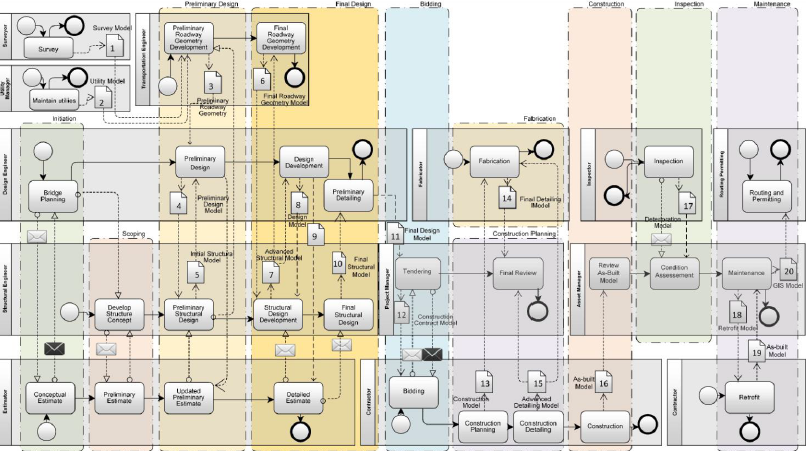- Keine Ergebnisse gefunden
- Anwendungsfälle
- Co-Creation Space
Community
Organisationen
Kooperationspartner
- Anmelden
IFC sample file and Information Delivery Specification according to the IFC Bridge Requirements Analysis Report (2018) Annex 1: Data Requirements
The transfer of the Requirements in Annex 1 to IDS was possible for all requirements covered by the 6 facets of the IDS v1.0 standard.
these are: Classes, Attributes, Relations, Materials, Classification, Properties.
All documents are licensed as a Creative Commons Attribution-NonCommercial-ShareAlike 4.0 International License
(Attribution-Non-Commercial-ShareAlike 4.0). Further information can be found at
![]()
The documents reflect the current best practice and do not claim to be complete. They should not to be understood in the sense of a generally valid recommendation or guideline from a legal point of view. The documents are intended to support appointing and appointed parties in the application of the BIM method. The documents must be adapted to the specific project requirements in each case. The examples listed do not claim to be complete. Its information is based on findings from practical experience and is accordingly to be understood as best practice and not universally applicable. Since we are in a phase in which definitions are only emerging, the publisher cannot guarantee the correctness of individual contents.
NOCH NICHT REGISTRIERT?
Registrieren Sie sich für den Use Case Management Service kostenlos, um Ihren ersten Use Case zu erstellen.
Registrierte Benutzer können den Download-Bereich und die Kommentarfunktionen nutzen.

IFC-Bridge extends the IFC data model in order to allow the exact description of bridge semantics and geometry. The IFC-Bridge project was initiated by the bSI Infra Room as a fast track project with a project duration of two years. Given the restricted project duration, it was necessary to focus on common and widespread bridge types and to include only those use cases that provide a high value to the end users and require reasonable efforts for defining and validating the necessary IFC extensions.
As a basis for defining the IFC-Bridge extensions, the international project team identified the most important uses cases of the data exchange processes in infrastructure projects.
The point of departure for this process had been provided by the outcomes of the IFC-Infra overall architecture process.
The defined list of use cases is not intended to be exhaustive. Instead, the most important use cases have been selected from interviews with experts having practical experience in
bridge projects. In addition, the input from several national initiatives was taken into account:
The basic requirements for the IFC-Bridge extension have been derived from the identified use cases, by focusing on geometry representations and semantic descriptions. They have
been distilled into three proposed Model View Definitions (MVDs) which were developed throughout the project.
This IDM is completely based on the attached IFC-Bridge Requirements analysis document.
The following bridge types, based on their structural system, are identified as the most common and widespread across the world. These bridge types are considered to be in scope
for IFC-Bridge. The developed IFC-Bridge extensions were validated using examples of these bridge types.
The following bridges types are also expected to be covered by IFC and the IFC-Bridge extension, however they were not subject to validation tests:
From a material viewpoint, the following bridge types are covered:
Particular emphasis are placed on realizing the necessary data structures for modelling prestressing systems.
Based on a careful analysis of the benefits of the individual uses cases and the complexity and effort involved with defining the necessary data structures, the project team decided to prioritize the following use cases for explicit consideration when designing the IFC-Bridge extension:
Due to their overly high complexity, the following use cases are out of scope of this fast-track project:
It is emphasized that the exclusion from the fast-track project does not mean that these use cases cannot be covered by future extensions of IFC-Bridge. It has to be noted in particular, that the full design-to-design use case which incorporates the model’s design logic, is excluded here as it would require software vendors to adapt modeling functionality, which is not deemed practical for reasons of competitive advantage, compatibility, and cost/benefit. Currently, there is no well-defined industry need that would justify this effort.
In order to identify the exchange requirements and associate them with dedicated data exchange scenarios the following process map has been defined (according to the IDM standard). Due to the large variety in national project setups and contractual models, the process map can only be seen as an example. Nevertheless, the defined exchange scenarios have a generic character and have, therefore, been a basis for the IFC-Bridge development.

Corresponding IFC Bridge use cases and proposed MVD per exchange scenario.
